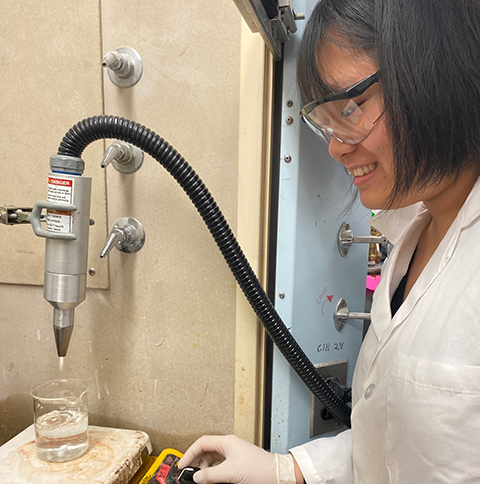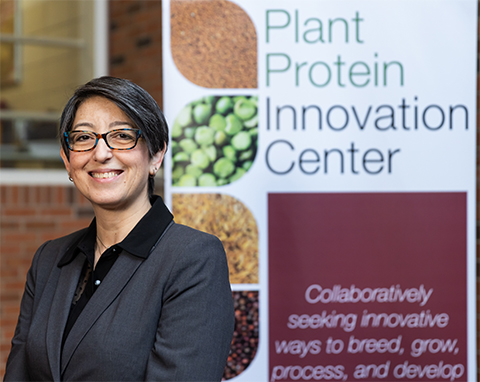
Modified pea proteins are shaping the future of meat alternatives
Have you ever bitten into a plant-based burger expecting the texture of meat and gotten an astringent, chewy alternative? You can probably blame your disappointment on the pea proteins that make up ground beef alternatives from brands such as Beyond Meat.
Meat analogs such as the Impossible burger are made with wheat proteins, which produce a more realistic beef-like texture. And Impossible products, compared to Beyond, are sold by almost twice as many fast-food retailers.

But your Impossible Whopper might be in for competition. B. Pam Ismail, founder and director of the Plant Protein Innovation Center, and colleagues at the University of Minnesota are working to modify pea and other legume proteins so their texture more closely resembles beef.
Why? Wheat gluten is one of the nine leading causes of food allergies in the U.S. And legumes such as peas are easy to grow and have several environmental benefits.
Greener alternatives
According to some experts, the beef industry is one of the driving causes of climate change. A single cow produces about 220 pounds of methane and requires a whopping 15,400 liters of water per year.
“Consumers are becoming more aware of the impact of the meat industry on the use of the current available land and the impact on the environment, such as greenhouse gas emissions, water use and soil health,” Ismail said.
Alice H. Lichtenstein, a senior scientist and leader of the Cardiovascular Nutrition Team at the Jean Mayer U.S. Department of Agriculture Human Nutrition Research Center on Aging at Tufts University, encourages people to cut down on the amount of meat they consume and shift to more plant foods for health as well as environmental benefits.

“The biggest differences between beef and plant-based meat alternatives are that the latter contain more unsaturated and less saturated fat and is better for the environment,” Lichtenstein said. “However, it is important to keep in mind that plant-based meat alternatives are an ultraprocessed food and tend to be high in sodium.”
Replacing beef with plant-based alternatives could slow the effects of climate change. However, the U.S. is also entrenched in a water crisis. According to a recent study, nearly half of the country’ freshwater basins may not be able to meet national water demands by 2071.
According to Lichtenstein, people can modify their food choices in other ways to make them better for the environment, for instance, by choosing plant-based sources of protein in their unmodified state such as legumes, peas or beans, and nuts, as well as dairy products and eggs in moderate amounts.
This is where pea crops come in. Compared to pea plants, wheat crops require about seven times more water per year. So, farmers prefer to grow peas over wheat.
Meat analog molecular mechanisms
Before Ismail founded the Plant Protein Innovation Center in 2018, she saw a disconnect between academic and industry food science.

“In industry, I noticed that there is a big lag in the knowledge and research on proteins,” Ismail said. “And I thought, if I don’t start the center, somebody else will.”
Ismail works with companies such as Bayer, Cargill, General Mills and other corporations to bring academic discoveries to the market. Driven by consumer demand for more healthful meat alternatives with realistic textures, these companies are investing resources in protein research.
Ismail and her team decided to see if they could modify the molecular structure of pea protein to impart a firm, gel-like texture.
Unlike wheat gluten and soy proteins, pea and chickpea proteins have low molecular weight polymers and form fewer disulfide bonds within and between protein molecules. Accordingly, pea and chickpea proteins form a relatively weak gel, making the end product loose and stodgy.
“We try to look at and adapt the furthest upstream steps during protein ingredient production,” Ismail said. “Can we protect the protein integrity during processing so it’s not damaged or make it more soluble or stable while forming a gel?”
Ismail and colleagues hypothesized that modifying pea and chickpea proteins with an enzyme might make them more likely to link up. They treated the proteins with transglutaminase, what Ismail calls a “meat glue” that promotes covalent bonds between glutamine and lysine, both of which are abundant in these proteins. This enzyme naturally occurs in the human body and promotes wound healing.
Compared with unmodified and commercially available pea and chickpea proteins, their transglutaminase-treated counterparts formed larger molecular-weight polymers and stronger gels.
“When you add transglutaminase, it promotes a certain linkage between protein molecules to make them form a longer polymer so that they can form a gel and hold water,” Ismail said.
After downstream processing, transglutaminase-treated proteins could create a firm, beef-like texture in a product like a burger, she said. Ismail and her team will work with company partners to figure out how these results could be efficiently translated into a marketable product.
“We need to develop more sustainable processes to get the protein out of the plant,” Ismail said. “There’s a lot of work involved when scaling something from bench to the industry scale. That’s why we partner with companies: to ensure these processes are scalable and sustainable.”
Enjoy reading ASBMB Today?
Become a member to receive the print edition four times a year and the digital edition monthly.
Learn moreGet the latest from ASBMB Today
Enter your email address, and we’ll send you a weekly email with recent articles, interviews and more.
Latest in Science
Science highlights or most popular articles

Targeting Toxoplasma parasites and their protein accomplices
Researchers identify that a Toxoplasma gondii enzyme drives parasite's survival. Read more about this recent study from the Journal of Lipid Research.

Scavenger protein receptor aids the transport of lipoproteins
Scientists elucidated how two major splice variants of scavenger receptors affect cellular localization in endothelial cells. Read more about this recent study from the Journal of Lipid Research.

Fat cells are a culprit in osteoporosis
Scientists reveal that lipid transfer from bone marrow adipocytes to osteoblasts impairs bone formation by downregulating osteogenic proteins and inducing ferroptosis. Read more about this recent study from the Journal of Lipid Research.

Unraveling oncogenesis: What makes cancer tick?
Learn about the ASBMB 2025 symposium on oncogenic hubs: chromatin regulatory and transcriptional complexes in cancer.

Exploring lipid metabolism: A journey through time and innovation
Recent lipid metabolism research has unveiled critical insights into lipid–protein interactions, offering potential therapeutic targets for metabolic and neurodegenerative diseases. Check out the latest in lipid science at the ASBMB annual meeting.

Melissa Moore to speak at ASBMB 2025
Richard Silverman and Melissa Moore are the featured speakers at the ASBMB annual meeting to be held April 12-15 in Chicago.

